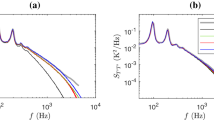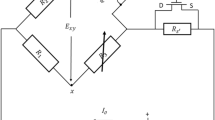Abstract
The information of the wire response is necessary for the estimation of corrections and uncertainty of temperature measurements. This paper describes the theoretical response of cold-wire sensors to temperature fluctuations in a fluid flow. Existing transfer functions of cold wires are approximate and implicit functions of frequency. We present the exact solutions of heat conduction equations for a cold wire and stubs taking account of the prong effect. Because the solutions have simple forms of elementary functions, we can easily calculate the frequency response of cold wires. Sample calculations are given under several typical conditions. Also, the instantaneous temperature profiles of a cold wire are obtained for the first time.
Similar content being viewed by others
Abbreviations
- c :
-
specific heat
- d :
-
wire diameter, 2r
- h :
-
heat transfer coefficient
- i :
-
probe current
- K :
-
(r/r s )2 (λ/λ s )
- L :
-
dimensionless wire length, l/r
- l :
-
wire length
- L c :
-
dimensionless cold length, l c /r
- l c :
-
cold length, \(\{ 2h/r\lambda ) - i^2 {\text{ }}R_0^* \beta /(\pi r^2 {\text{ }}\lambda {\text{)\} }}^{ - {\text{ }}1/2}\)
- M :
-
time constant, ϱ cr/(2 h)
- R :
-
dimensionless wire radius, hr/λ
- R * :
-
electrical resistance per unit length
- R Emphasis>/* a :
-
electrical resistance per unit length at temperature θ a
- R *0 :
-
electrical resistance per unit length at temperature θ 0
- r :
-
wire radius
- T :
-
dimensionless time, h 2 κ t/λ 2
- t :
-
time
- U a :
-
fluid velocity
- X :
-
dimensionless coordinate, x/r
- x :
-
coordinate along wire
- Z :
-
radius ratio between stub and wire, r s /r
- α :
-
electrical resistivity
- β :
-
thermal coefficient of electrical resistance
- κ:
-
thermal diffusivity, λ/(ϱ c)
- λ :
-
thermal conductivity
- ϱ :
-
density
- η :
-
gain
- η t :
-
plateau value of gain
- Θ :
-
dimensionless temperature, \((\theta - \theta _\infty )/(\overline {\theta _p } - \overline {\theta _a } )\)
- Θ b :
-
\((i^2 /\pi ){\text{ \{ (}}l_{cs} /r)^2 {\text{ }}(R_{as}^* /\lambda _s ) - (l_c /r)^2 (R_a^* /\lambda )\} /\overline \theta _p )/(\overline {\theta _p } - \overline {\theta _a } )\)
- Θ c :
-
dimensionless temperature of junction of wire and stub, \((\theta _c - \theta _\infty )/(\overline {\theta _p } - \overline {\theta _a } )\)
- Θ m :
-
dimensionless mean temperature of wire, \((\theta _m - \theta _\infty )/(\overline {\theta _p } - \overline {\theta _a } )\)
- θ :
-
temperature
- θ a :
-
fluid temperature
- θ c :
-
junction temperature between wire and stub
- θ m :
-
mean temperature of wire
- θ 0 :
-
standard temperature
- θ ∞ :
-
wire temperature of infinite length without fluid temperature fluctuations, \(\overline \theta _a + i^2 (l_c /r)^2 {\text{ }}R_a^* /\pi {\text{ }}\lambda )\)
- ΔΘ a :
-
dimensionless amplitude of fluid temperature fluctuations, \(\Delta \theta _a /(\overline \theta _p - \overline \theta _a )\)
- Δθ a :
-
amplitude of fluid temperature fluctuations
- τ p :
-
time constant ratio of stub to wire, M p /M
- φ :
-
phase angle
- Ω :
-
dimensionless frequency, λ 2 ω/(h 2 κ)
- ω :
-
frequency of temperature fluctuations
- p :
-
prong
- s :
-
stub
References
Collis, D. C.; Williams, M. J. 1959: Two-dimensional convection from heated wires at low Reynolds numbers. J. Fluid Mech. 6, 357–389
Hojstrup, J.; Rasmussen, K.; Larsen, S. E. 1976: Dynamic calibration of temperature wires in still air. DISA Information No. 20, 22–30
JSME 1986: Data Book (Heat Transfer), 4th edn., pp. 314–330. Tokyo: Jpn. Soc. Mech. Engrs.
Millon, F.; Paranthoen, P.; Trinite, M. 1978: Influence des echanges thermiques entre le capteur et ses supports sur la mesure des fluctuations de temperature dans un ecoulement turbulent. Int. J. Heat Mass Transfer 21, 1–6
Paranthoen, J. C.; Petit, C.; Lecordier, J. C. 1982: The effect of the thermal prong-wire interaction on the response of a cold wire in gaseous flows (air, argon and helium). J. Fluid Mech. 124, 457–473
Perry, A. E.; Smits, A.; Chong, M. S. 1979: The effects of certain low frequency phenomena on the calibration of hot wires. J. Fluid Mech. 90, 415–431
Petit, C.; Paranthoen, J. C.; Lecordier, J. C. 1981: Influence of Wollaston wire and prongs on the response of cold wires at low frequencies. Lett. Heat Mass Transfer 8, 281–291
Sigmund Cohn Corp. 1978: Properties of metals and alloys. New York
Author information
Authors and Affiliations
Rights and permissions
About this article
Cite this article
Tsuji, T., Nagano, Y. & Tagawa, M. Frequency response and instantaneous temperature profile of cold-wire sensors for fluid temperature fluctuation measurements. Experiments in Fluids 13, 171–178 (1992). https://doi.org/10.1007/BF00218164
Received:
Issue Date:
DOI: https://doi.org/10.1007/BF00218164




